Wayne Munro's 1960s paipo board.
Board specifications (centimetres).
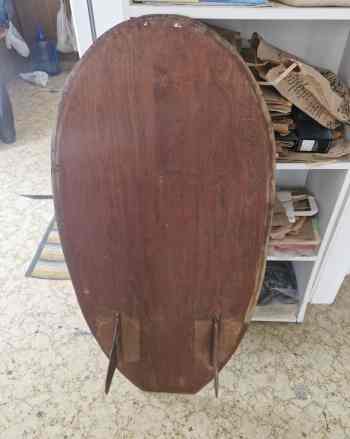
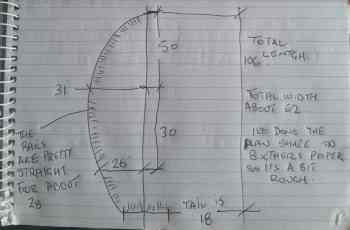
Photo courtesy of Mark Munro. Drawing by Jeff Day.
| MyPaipoBoards | Paipo Forums | About | Interviews | Bibliography | WaveRiders Info | Search MyPaipoBds | Donate | |
Mark grew up surfing the solid waves of Cronulla at a time when plywood paipo boards were briefly popular in the line up. He would then go on to ride waves around the world on his spoon kneeboard, long after the spoon design fell out of popularity. These days he rides higher volume kneeboards as well as a longboard, on small days. He has a keen recollection of adventurous times at Cronulla in the 1960s and beyond.
When Paul Burridge said you had a photographic memory for things it seemed a good idea to talk to you have paipo boards and Cronulla.
I know a bit about it because I was there from the heydays.
When do you call the heydays?
Paipos went through two eras at Cronulla Point. In the early '60s they were really heavy sort of boards, made of solid wood. Later, near the end of the '60s they were made from marine ply. That was the evolution of it. The main rider of the heavy boards was a guy called Barry Hutchins. He was the top paipo rider of the heavy boards, from what I can remember. I used to hang out with his brother Bruce. The best paipo was by a called Dave Croft, who developed this paipo, my brother still has one, it's a particular shape.
Is this the dark brown board, almost oval?
Yeah, yeah, it's almost oval. I can't tell you how long they were. I used to ride mals. I broke a mal out the point on a big day in '67, I think it was. I took up riding paipos. We used to kneel on them and we had a guy out Cronulla Point who sat on them, riding backwards.
|
Wayne Munro's 1960s paipo board. |
Board specifications (centimetres). |

|

|
|
Photo courtesy of Mark Munro. Drawing by Jeff Day. |
|
Who was that?
A guy called Steve McNally. He was well known, he had a skill, he could drop and climb, while sitting on them.
So he didn't just go straight?
No, a good surfboard rider too. Cronulla was the main hub for it, in those days. I didn't go to the north shore, there were a few people who mucked around with them.
Perhaps the best paipo rider that I ever saw, was a friend of mine, Jeff Day.
I'm just looking through a list of names I have collected over the years. I don't think I've heard of him.
Jeff Day was really good. He was actually doing reentries before anyone knew what they were.
Kneeling or prone?
No lying down. He must have started '66 or '67, somewhere around then.
|
Jeff 'Ocka' Day floating. |
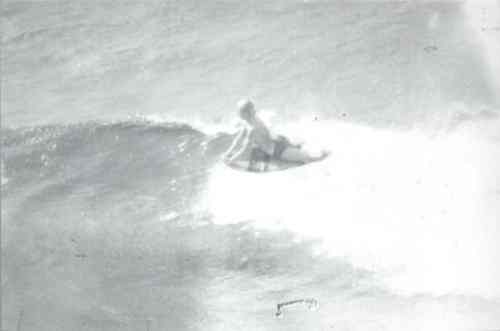
|
|
Photo courtesy Jeff Day. |
The other thing that interested me, you might have been a bit young, but Barry Regan told me a group of guys took up riding bellyboards after the US team went to Cronulla in 1956 (see Note 1).
I wasn't there then. I started going to the point in '66.
Barry Hutchins and the heavy paipos were before that. They were on the way out when the new group came in.
Were the heavy boards twin fins?
Yeah, twin fins.
|
1965 Barry Hutchins bellyboard. |
1965 Barry Hutchins bellyboard. |
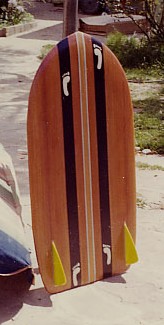
|
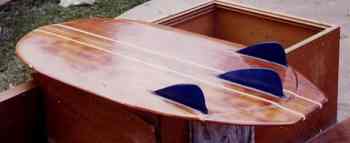
|
|
Photos courtesy Barry Hutchins |
|
Barry Hutchins experimented with different fin set-ups.
He was the main instigator, he had some very good heavy boards. I watched him surf one day out the point on a big day. His boards went really well on big days. The other ones mostly 6, 7, 8 feet — no bigger than that.
The later ones?
Yeah the marine ply ones.
They're hard to get into waves?
There is a certain way of building them. You put weights on them when making them, so they had a curve in the middle. My brother still has one. Dave Croft was the guy, I don't know where he got it from but that became the main shape, because those boards went really well, high performance sort of boards.
So fairly early on you came to start kneeling on them?
I used to kneel on them for a couple of years, then I got a Greenough spoon in 1968. I rode Greenough spoons for almost 40 years.
|
Mark Munro at Shark Island, 1972. |
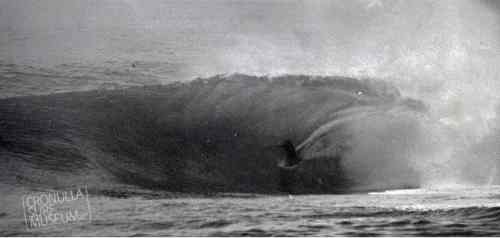
|
|
Unknown Photographer. (2013, May 2). Mark Munro at Shark Island. 1972. Cronulla Surf Museum Facebook group posted the photo as 1979 but Paul Burridge |
Most people gave up on them for higher volume boards?
Well they do, but I persevered with spoons because I didn't like getting caught inside on big days. You could dive to the bottom, but the only disadvantage was the late take offs.
That's the trade off.
That's the trade off, I surfed them all around the world. I used to go to Nias with them, I think I'm the only guy to have surfed Nias on a spoon.
You mainly see them in collections, but a guy from the states still rides the same spoon he had from the 1970s.
I sold a couple of them off, I still have one from '68. I stopped riding them about eight years ago, took up foam boards. I was just in Nias recently, but got hurt there. That's my last time going because I'm 75.
|
Mark's spoon with shallow bow (described below). |
Spoon foil. |
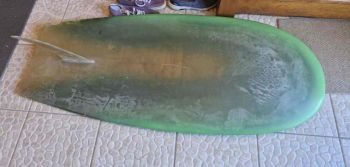
|
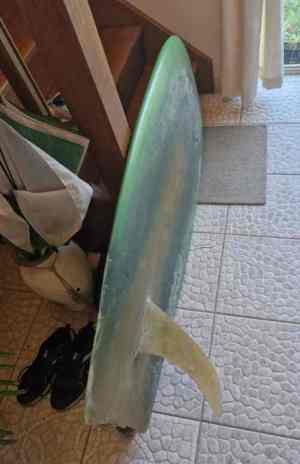
|
|
|
|
It catches up with you.
I can't surf heavy waves like that anymore. Nias is really heavy.
I'd heard the reef had changed after the tsunami.
It did, I used to like it before the tsunami. It was a lot better. It had a middle section where you could really perform on it. Now it's a big tube. It still has a bit of a middle section.
It's consistent. This year was mainly onshore. It was the worst year in 12 years. I said to my wife, "it's my last time there". I went there in '81, there were no losmens around the point, there was nothing. It's a lot different now, there's losmens everywhere, they have electricity on.
You must have had some good waves there?
I was very lucky when it comes to surf. In '85 I had it on for three weeks straight, every day. In '87 it was on again. I got there on the day it came up and the day after i left, it went flat.
Sometimes you can be lucky like that.
Lucky for surf. I've surfed all around the world in different places. I was in Mauritius for six weeks. This was 1973. It was the place to go in those days. We went on a cargo boat to South Africa and I spent two winters at Jeffreys Bay.
I never got to Morocco but my mate John Waterworth did.
Where else?
The Mexican Pipeline, only on a small day, 5 feet, on a spoon. I couldn't imagine going out at 10 or 15 feet. A friend of mine, Gary Hughes, he broke a shoulder there last year. I saw the footage and went "shit". He was up the top of this wave and decided he wasn't going to go, he got sucked over. It breaks anywhere up to 50 feet in the same place, it's a sand bank. If you go on the shore there are all crosses there of surfers who have died there. It's a heavy place. While we were there we got Barra de La Cruz on. We got it on pretty good but not like the Quiksilver Pro. It can be flat for five years — so I've been told. We were just lucky because there had been a hurricane about a month before that. It was pretty good but wasn't classic.
Went to Mexico in 2012 and 2013. Then I went to the Mentawis. India is a good place — it was one of my favourite countries. I used to like Afghanistan. Once the Russians moved in it was all over.
You took the spoon with you to Jeffreys Bay?
I surfed in Sri Lanka, Mauritius, Tahiti. In Tahiti I was surfing a foam board.
What do you mean by a foam board?
A normal kneeboard. We stayed in Haapiti and had to paddle a mile and a half across the lagoon to the break. It was a left hander, I don't like left handers that much but I persevered. I've taken spoons over the world except the last 8 years, I've been riding foam boards.
How long are the foam boards?
5'8" thrusters.
From what I've heard a few kneeboarders have now been riding prone because their knees gave out.
My knees have never gave out, I've got good knees but I haven't done anything radical the last 10 years. I didn't do super big reentries and free falling, and all that stuff. I'm laid back these days.
The kneelos riding prone, had boards at least 5'6".
My spoons were 4'9". I got into spoons and worked out how they were made properly, so they went not like the Hayden Kenny ones where the bowl at the front was too deep. They never really went , they just went in straight lines. The boards I rode were highly manoeuvrable, anywhere from 2 to 8 feet.
|
Mark's Peter Clarke spoon. |
Another of Mark's spoons. |
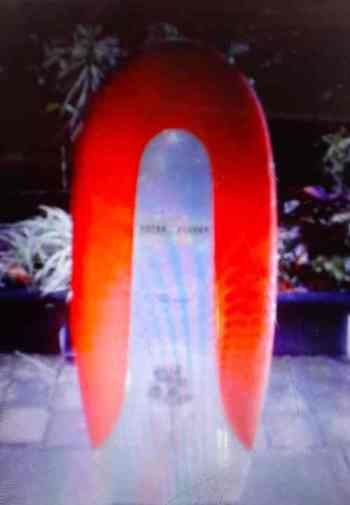
|
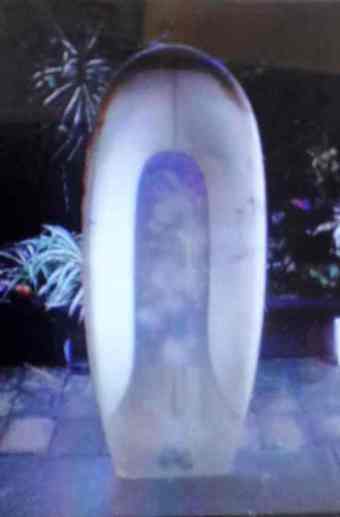
|
|
Photos courtesy Jeff Day. |
|
So who was making them?
I originally got them made by Keyo, by Neil Purchase. He made my one and one for a guy called Ian Cameron. We both got these spoons and knew nothing about them. He made the bow correct. My first spoon was 4'6". I thought I'd get one a little bigger, so made it 4'9". There is a certain way you turn the glass down in the corners, so you lean back and it works like a spring effect. The whole thing is a rocket. I was out at Nias in a big swell in '85, 15 feet plus for a week. I was out there with a guy called Dugga Warren, from Phillip Island. Just me and him out in the water. Because i had a spoon I could duckdive. A set came through well over 20 feet. He was going to take it, it was sort of breaking further out on a reef level with Indicators. I was down the bottom when it broke, I had to dive to the bottom with my arms and legs wrapped around my board, got spun like a top under the water, but survived it. If I had been on a foam board, I'd be dead.
The usual big day is 6-10 feet. You get bombs come through. I've got a bit wary as I've got older. You go out on a 6 feet day, every now and then a 10 feet bomb comes through and cleans up everybody.
|
Spoon made by Paul "Bear" Burridge. |
Spoon made by Paul "Bear" Burridge. |
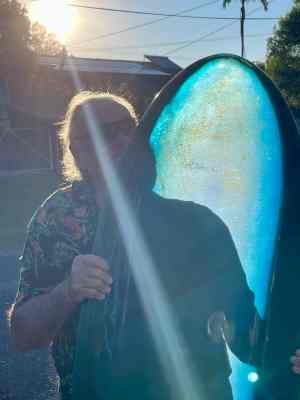
|
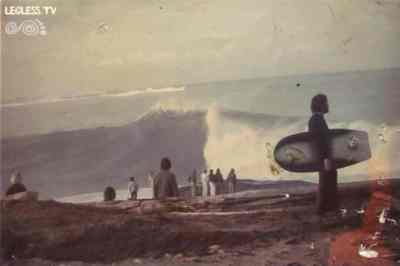
|
|
Photos courtesy Paul Burridge and Legless. |
|
You get those places where rogue waves come through.
They're rogue waves, I was there on a big day a couple of years ago, it was 8-12 feet and this set came through, a monster, because the reef has come up since the tsunami, the whole reef nearly drained all dry where you were taking off. A set came through, it wasn't dry but it didn't have much water on it. We stay in a losmen that overlooks the break, sitting, watching and this guy got caught inside. We thought he'd drowned but somehow he made it back to the keyhole. I don't know how he did it.
|
Mark bottom turn at Nias. |
Mark tubed at Nias. |
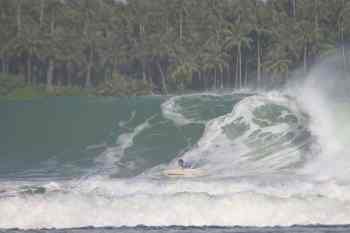
|
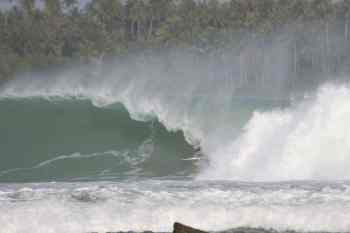
|
|
Photos courtesy Steen Barnes. |
|
You see guys get insane waves but every now and then, they pay the price.
Everybody pays the price. I nearly drowned at Nias the year before. My legrope got caught on the bottom and I didn't know what had happened and I couldn't come up. Fortunately it loosened. A heavy trip. I've retired from Nias now.
I've heard it's a more crowded these days.
Nias is still alright. It still gets around 20-25 in the water, but you still get waves. It's not like surfing Snapper with 300.
Where do you surf these days?
I've got a stretched ligament from getting sucked over and am still recovering. I used to mainly surf around Snapper, Rainbow and all those places up there. As I'm getting a bit older I might just stick to beachbreaks and ride a mal, and occasionally ride a kneeboard.
So you kept stand up surfing while you were riding a kneeboard?
I still used to go out on mals sometimes on small days because that's what I first started surfing.
We used to go along the beach at Cronulla and collect drink bottles. We could make five pound a day, we're talking 1963.
That was a lot of money.
That's heaps a lot of money mate. Me and my brother, we'd spend it on hiring out surfboards. There was a guy would come down in an old ute packed full of surfboards. That's how we started surfing. Then I got a surfboard for Christmas in 1964.
The broken mal board was in 1967?
I made surfboards for three years. I had another surfboard that broke in half on a big day at Cronulla Point.
So you rode the paipos from about 1967?
to about 1968, about a year and a half. Then I got into kneeling on them and all that sort of stuff. Dave Croft paipos were great for kneeling. Once you got on a wave they motored.
|
Dave Croft. Mark identified this as Dave's first paipo board. |
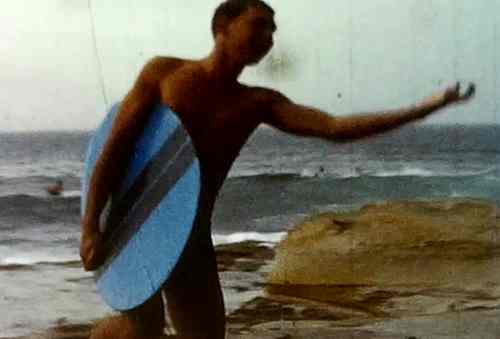
|
|
Photo courtesy of Cronulla Surf Co. and Steve Cohen. Cronulla - South Coast Surfing 1960s. |
They were fairly thin?
Yeah I know, but once you got speed up — they were not as good as a proper kneeboard but they were an introduction into it. Me and Ian Cameron got our spoons, October '68 or something.
|
Mark Munro, 1970s. |
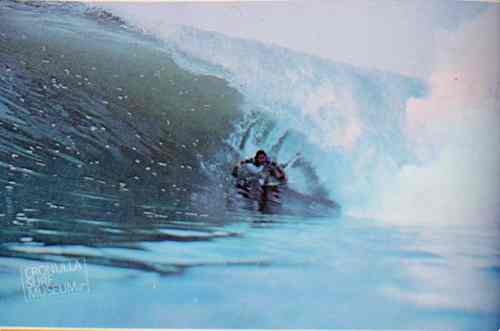
|
|
Source: Unknown (1977) Surf 1(2), 27. Courtesy of Cronulla Surf Museum Facebook group. December 17, 2013. |
How many people would you see on paipos?
In those days, there wouldn't be anymore than 10 out at a time. It wasn't super packed. That's just a ball park figure, sometimes there would only be five. There were a couple of really good riders.
I'll read out some names I've been given: Lloyd Webster, Ronnie Stenhouse, Nigel Dwyer, Jeff Rowe.
Jeff Rowe, he's a good friend of mine. I was with him in South Africa. He lives up here on the coast.
Barry Darby, Dave Shaw?
Dave Shaw never rode paipos as far as I can remember, he was a body surfer. (See Note 2.)
Steve "Bonehead" Doney.
Oh yeah Doney, he specialised in rubber mats. He actually caught a wave at Waimea one time, free fell down the face and the thing exploded. He's a tough boy, he lives in Canberra.
|
Steve Doney. |
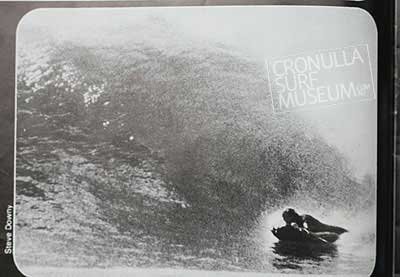
|
|
Bruce Channon photo, courtesy of Cronulla Surf Museum Facebook group. June 16, 2011. |
Dave Croft, who you mentioned.
Dave Croft. He's dead, he's passed on.
Geoff Bird, Adam Plate, Geoff Day, Bernard McNally.
I know Geoff Bird. Bernard McNally, that's Steve McNally's brother. Put Steve McNally down because he was one of the main guys, he used to sit backwards on them.
Lewis Cawsey? (See Note 3.)
Didn't know him.
Oke Day.
That's Ocka Day. Jeff Day. Ocka was his nickname. He is the master of paipo. He's got a lot of good photographs of him surfing in those days. He lives near Long Jetty. He's the same age as me.
While I remember, there was a guy from Caringbah. I think he's dead now, called Lenny Hedges. I used to work for him. Me and a guy called ray Ryan used to work building his yachts. He got into making paipo kits, he used to sell them. He was very successful for quite a while, we're talking the '60s. I've seen a photo of his ad, it says boards ranged from 27 to 35 inches, twin finned. They came with assembly instructions. Lenny Hedges stuff. He used to make them up. I knew him well, he was just a real eccentric character. He made these ferrous concrete yachts. We'd used to go around and work for him. We'd have to sand them, all this sort of stuff. Crazy.
|
A Len Hedges bellyboard kit advertisement. |
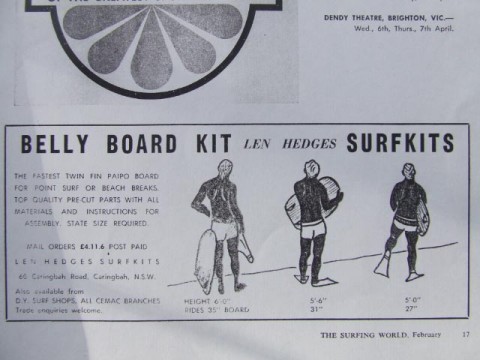
|
|
Source: Advertisment. (1966). Belly Board Kit. The Surfing World 7(4), 17. Photo courtesy Gary Clist. |
Ray Ryan said he surfed with him in a dory.
Ray Ryan. He lives in Tradewinds above Cronulla Point. He was one of the first guys to surf Shark Island really big. He got washed across the island and his mate had to paddle across and rescue him. About 1966. I went with him on a surfing trip up the coast. A far out dude.
He told me Cronulla attracted eccentrics.
He was a QANTAS steward.
How about Weldon Dines, Mr. Wells.
I know Mr. Wells quite well. He used to make double hand planes, I rode double hand planes, a few other guys out the point were spectacular with hand planes, a guy called Robert Dalton. He went for the HIgh School Certificate, he was never at classes and he came top of the state in a couple of subjects. He was an intellectual genius and he designed a special hand plane, with a sort of curve in it, underneath, with a hook at the end. He'd be dropping out of the wave and his hand would still be up there.
Old Wellsy used to come down. He used to live somewhere around Hurstville. I would hitch to the beach from Beverly Hills and he'd pick us up a couple of times. He would be long gone now, he was a lot older than me. If he was still alive he'd have to be in his 90s.
I've seen old footage of Cronulla and most guys were kneeling (see Note 4).
A lot of the guys on paipos graduated to kneeboards. Paul Burridge was a very big wave rider (see Note 5). I go to Nias with him, we used to go to Nias all the time.
|
Paul Burridge at Shark Island, riding a mate's custom Barry Bennet mini mal 5'8" single fin. |
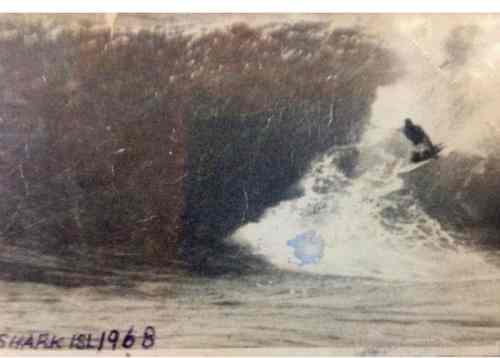
|
|
Photo courtesy of Cronulla Surf Museum Facebook group. October 28, 2023. |
I'd be interested in photos of the board.
Which board, the kneeboard, the paipo?
Do you still have the paipo? The spoon sounds interesting as well.
My brother has it. I'll take two or three shots of his paipo and the spoon.
|
Wayne Munro's 1960s paipo. |
Wayne Munro's 1960s paipo. |
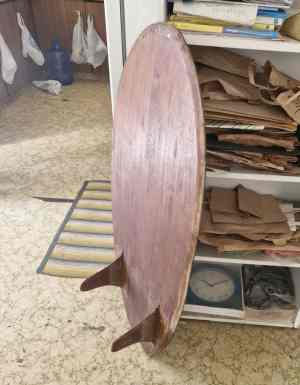
|
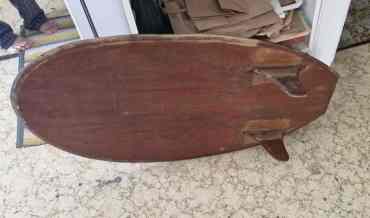
|
|
Photos courtesy Mark Munro. |
|
How long did your brother ride the paipo — the same as you?
Yeah, he gave up surfing after a while. He hasn't surfed for years but still has his paipo.
|
Wayne (left) and Mark at Broken Head. Wayne's paipo is in the foreground. |
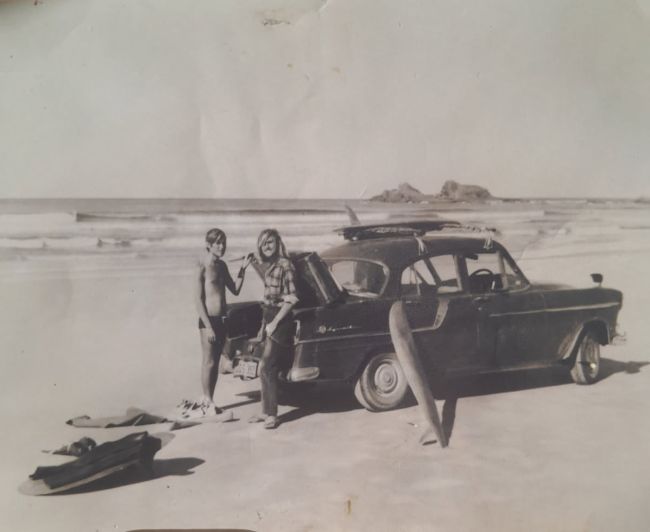
|
|
Photo by Jeff Day. |
If you're still getting out at Nias until this year you're still doing pretty well.
Yeah, well that's right. I'm the oldest guy there. Last year I thought the same thing. This year I thought I'd do one more effort at it.
Notes
Note 1: This photo was taken at Cronulla in 1956 and depicts boards of the visiting Hawaiian-US lifeguard teams. In the foreground is a bellyboard with a hint of a single fin showing. The photographer was Barry Regan who advised that Lloyd Webster, Ronnie Bowler, Neal Stenhouse and Nigel Dwyer started riding bellyboards at Cronulla in the late 1950s. The other evidence for the use of single fin bellyboards comes from photos of a 1958 surf trip to Avoca, in Ray "Dags" Greenaway's old Austin A30. The balsa bellyboard in the photos belonged to Ray "Hitcho" Hitcheson. After the 1960s there were various attempts to make fibreglass bellyboards (e.g., in the 1970s Terry Atkinson from Gordon and Smith glassed a board shaped by a friend of Jim McNamara, Graham King made a small single fin board and Anthony O’Neill from Emerald surfboards in the 1980s made twin finned, boogie board style boards) but they never gained the popularity of the wood or ply boards of the 1960s.
|
US-Hawaiian team boards 1956. |
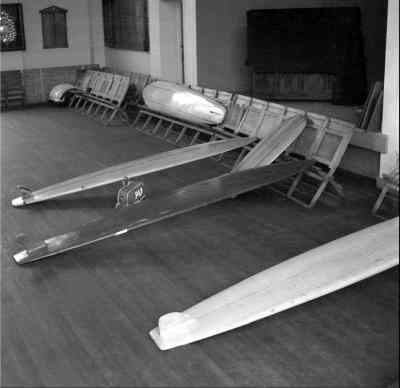
|
|
Photo courtesy Barry Regan. |
|
Ray "Dags" Greenaway and Garry Birdsall. |
Garry Birdsall and John "Daisy" Day. |
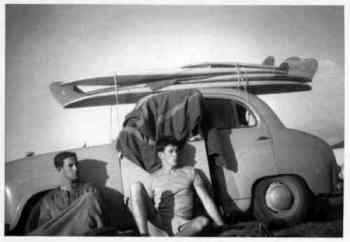
|
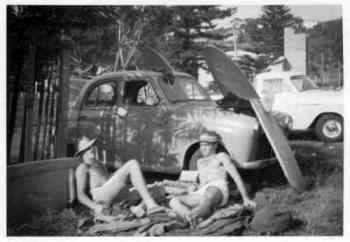
|
|
Ray Hitcheson photo, courtesy Garry Birdsall. |
|
Note2: While Mark referred to Dave Shaw as a body surfer, on March 3, 2025 in a Facebook post, Paul Burridge noted that "... Dave Shaw used [to] ride Mats heaps when he wasnt taking great photos from water n shore".
Note3: Lewis Cawsey, Greg Vaughn and friends rode paipos around Cronulla from 1963 to 1965. They featured in a 1964 issue of Surfabout. Lewis also participated in a 2014 paipo interview.
|
Chris Cramey and Greg Vaughn at Cronulla Point. |
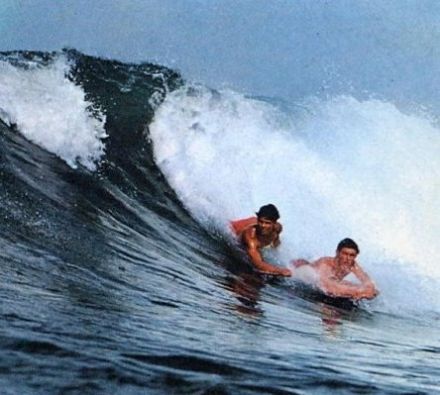
|
|
Source: Unknown (1964). Surfabout. 3(1) Cover. Courtesy Al Hunt. Daryl Sykes identified the handboarder as Chris and not Lewis Cawsey. |
Note 4: Pete Berry took footage of kneeboard & prone surfing at Cronulla. This early 1970s footage has been posted on Youtube
Cronulla paipo footage.
Note 5: Paul "Bear" Burridge was a kneeboard shaper and Cronulla local, who was the first to surf Shark Island over 4 feet.
|
A 7'4" assymetric flex tail. |
"Bear" made the board especially for Nias. |
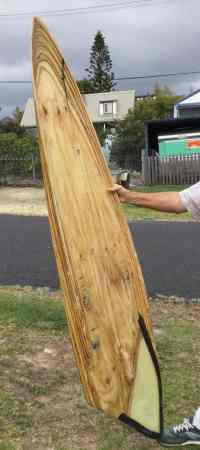
|
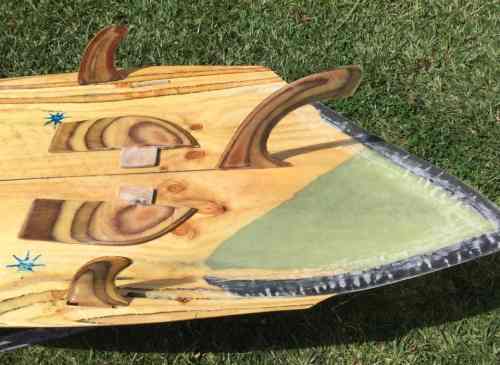
|
|
Photos courtesy Paul "Bear" Burridge. |
|
| MyPaipoBoards | Paipo Forums | About | Interviews | Bibliography | WaveRiders Info | Search MyPaipoBds | Donate | |
| I am aware that some of the images and other content on this website may be subject to copyright and
will gladly remove any such items if so requested by the genuine holder
of the rights. Such content is not used for commercial exploitation. The sole purpose is to share knowledge with enthusiasts and interested parties. To the extent possible copyright holders have been contacted for permission to share content on this website. Likewise please respect the copyright content of this site. | |
|
All
contents of this site ©1998-2025 Rod's Home Port for SurfMarks and MyPaipoBoards. All images within this section copyright of respective credited contributor. |
eMail me at:
The Paipo Research Project
|